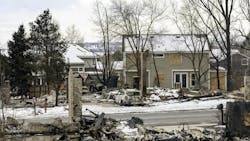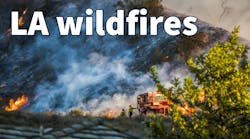How a wildfire challenged Boulder County’s water supply in a matter of hours
Following a wet spring that resulted in a vast amount of vegetative growth, Boulder County, Colorado, experienced a very dry fall. The dry conditions zapped the moisture out of the vegetation.
The county was under a red flag for extremely windy conditions. The heavy winds were coming from the west through the east, enveloping the open area of the county. The dry vegetation, combined with the windy conditions, created the perfect recipe for a fire to break out. What ensued over the following hours would be studied for years to come.
2021 Marshall Fire case study
A case study, titled “Water Utility Resilience: A Case Study of the 2021 Marshall Fire,” was conducted and prepared by Professor Brad Wham, University of Colorado, Boulder; Professor Erica Fischer, Oregon State University, and University of Colorado, Boulder; and Graduate Assistant Rachel Geiger.
Geiger and Wham presented the findings of their case study at the American Water Works Associations (AWWAs) Annual Conference & Exposition (ACE) in Denver, Colorado, 25 minutes from where the fire took place.
Geiger detailed the day the fire broke out, as well as the impact of it on five nearby water systems and the residents they serve.
First fire reported in Marshall at 11:06 a.m.
Heavy winds combined with the fuel of the vegetation quickly spread the fire. The fire carved a path straight for the city of Louisville and town of Superior. Louisville has two water treatment plants serving 20,000 people and Superior has one plant serving 17,000 people.
The hours following ignition
Within the first two hours the Louisville southern treatment plant had to evacuate, and Superior’s water treatment plant was preparing to evacuate. When the fire reached Louisville’s southern treatment plant, it resulted in a loss of electricity.
The water plants all utilized the same type of electricity, with backup generators that used natural gas systems. While the fire was approaching, gas was shut off by the regional power utility.
During this time, the town of Superior began evacuating.
“Two hours after ignition, the fire jumps over highway 36,” Geiger said. “This is a major road that connects Denver to Boulder.”
Geiger stated that during her talks with people, many thought the highway would operate as a fire break, but it did not. The spread of the fire led to the evacuation of Louisville as well as the East Boulder County Water district, which serves roughly 300 people and receives water from the town of Lafayette.
In response to this, Louisville decided to push its northern treatment plant to maximum capacity due to increased water demand. Superior’s water treatment plant lost power as the fire pushed up to it. The plant did not suffer any direct damage, however its generator house was destroyed.
Then, the East Boulder County Water District lost power.
Louisville and Superior began communicating with each other. Louisville’s northern plant began pumping 1 MGD to Superior via an interconnect in the distribution system to support firefighting efforts, and utility workers began working to restore power. Through some effort, Superior found success in restoring two-phase power, with about half the system receiving electricity.
Meanwhile, Louisville became curious on what its water levels were. Due to the power outages, readily available data was not accessible, which required a manual read of the storage tanks only accessible if a technician were to climb on the tanks during extreme winds and a spreading fire to get a measurement. They did.
“Imagine climbing up this under 100mph winds and smoky conditions,” Geiger said, “but that’s what’s required in this situation.”
The technicians looked down into the tanks and reported one to two feet of water. Louisville and Superior decided to close the interconnect, with Louisville sending untreated water into the distribution system with the one goal of maintaining water quantity.
During this time, the Colorado Department of Public Health and Environment (CDPHE) issued a boil water advisory for all three systems due to the partially treated water and concerns of depressurization.
Superior’s SCADA system then came online and showed 15% storage, followed by reports of low pressure or no water at hydrants.
Both the Louisville southern treatment plant and Superior plant were able to bring power back online thereafter. With Superior’s generator being down, the power company trucked in a tank through the fires to connect to the generator to restore power.
The facilities were at maximum production capacity, but were still losing water.
13 hours after ignition
The fire ravaged through homes, collapsing frames and destroying foundations, leading to water leakages across the burned area.
The utilities began a troubleshooting process, sending crews behind the fire line where there was no longer active firefighting to shut off water.
“One example was at a Target that had indoor fire sprinklers that were running nonstop,” Geiger said.
Around midnight the winds began to die down, and the decrease in fire intensity combined with the shut offs allowed water pressure and supply to build again.
The next day
The day following the fires brought freezing temperatures along with snow. The concern shifted to freezing pipes and flooding in evacuated homes. Utilities started to receive calls to shut off water.
“One water utility director actually gave out his personal phone for people to text him and let him know ‘Do you need me to shutoff your water?’ because the city servers were down,” Geiger said.
Aftermath of the Marshall Fire
Within the first week, utilities began damage assessments and public communications. All three systems were required to conduct system wide flushing to lift boil advisories. They sent out a call and pulled in volunteer crews and crew members who worked day and night in the freezing conditions to get the advisories lifted by day seven.
Researchers, consultants and people with experience came to the area and met to discuss the science regarding the fire’s toll on the water systems. Utilizing that input and advice allowed the utilities a path forward.
Over the next several weeks there was a lot of water testing. The data was gathered on maps which included the location of the tests, what tests were done, the results of the tests and the date of the test. These were then used to inform the public about water quality.
That communication became a two-way street. In the town of Superior, there were reports of ashy taste and odor, which started on day 11. Roughly six months later they identified the problem – ash in the terminal reservoir. Following this, Superior designed, constructed and began operating a new granular activated carbon system as a pretreatment process.
“Getting communication out to the public, as well as listening to what they’re saying, is a big role in how they recovered in this process,” Geiger said.
About the Author
Alex Cossin
Associate Editor
Alex Cossin is the associate editor for Waterworld Magazine, Wastewater Digest and Stormwater Solutions, which compose the Endeavor Business Media Water Group. Cossin graduated from Kent State University in 2018 with a Bachelor of Science in Journalism. Cossin can be reached at [email protected].


